Queen Elizabeth The Queen Mother

Queen Elizabeth The Queen Mother

| Elizabeth Bowes-Lyon | |
|---|---|
| Queen consort of the United Kingdom and the British Dominions | |
| Tenure | 11 December 1936 –6 February 1952 |
| Coronation | 12 May 1937 |
| Empress consort of India | |
| Tenure | 11 December 1936 –15 August 1947 |
| Born | Elizabeth Angela Marguerite Bowes-Lyon[1] (1900-08-04)4 August 1900 Hitchin or London, England |
| Died | 30 March 2002(2002-03-30)(aged 101) Royal Lodge, Windsor, Berkshire |
| Burial | 9 April 2002 St George's Chapel, Windsor Castle |
| Spouse | George VI (m.1923; died 1952) |
| Issue |
|
| House | Windsor (by marriage) |
| Father | Claude Bowes-Lyon, 14th Earl of Strathmore and Kinghorne |
| Mother | Cecilia Cavendish-Bentinck |
Elizabeth Angela Marguerite Bowes-Lyon (4 August 1900 – 30 March 2002) was the wife of King George VI and the mother of Queen Elizabeth II and Princess Margaret, Countess of Snowdon. She was Queen consort of the United Kingdom and the Dominions from her husband's accession in 1936 until his death in 1952, after which she was known as Queen Elizabeth The Queen Mother,[4] to avoid confusion with her daughter. She was the last Empress consort of India.
Born into a family of British nobility, she came to prominence in 1923 when she married the Duke of York, the second son of King George V and Queen Mary. The couple and their daughters embodied traditional ideas of family and public service.[5] She undertook a variety of public engagements and became known for her consistently cheerful countenance.[6]
In 1936, her husband unexpectedly became king when his older brother, Edward VIII, abdicated in order to marry the American divorcée Wallis Simpson. Elizabeth then became queen. She accompanied her husband on diplomatic tours to France and North America before the start of the Second World War. During the war, her seemingly indomitable spirit provided moral support to the British public. After the war, her husband's health deteriorated and she was widowed at the age of 51. Her elder daughter, aged 25, became the new queen.
After the death of Queen Mary in 1953, Elizabeth was viewed as the matriarch of the British royal family. In her later years, she was a consistently popular member of the family, even when other members were suffering from low levels of public approval.[7] She continued an active public life until just a few months before her death at the age of 101 years, 238 days, which was seven weeks after the death of her younger daughter, Princess Margaret.
| Elizabeth Bowes-Lyon | |
|---|---|
| Queen consort of the United Kingdom and the British Dominions | |
| Tenure | 11 December 1936 –6 February 1952 |
| Coronation | 12 May 1937 |
| Empress consort of India | |
| Tenure | 11 December 1936 –15 August 1947 |
| Born | Elizabeth Angela Marguerite Bowes-Lyon[1] (1900-08-04)4 August 1900 Hitchin or London, England |
| Died | 30 March 2002(2002-03-30)(aged 101) Royal Lodge, Windsor, Berkshire |
| Burial | 9 April 2002 St George's Chapel, Windsor Castle |
| Spouse | George VI (m.1923; died 1952) |
| Issue |
|
| House | Windsor (by marriage) |
| Father | Claude Bowes-Lyon, 14th Earl of Strathmore and Kinghorne |
| Mother | Cecilia Cavendish-Bentinck |
Early life
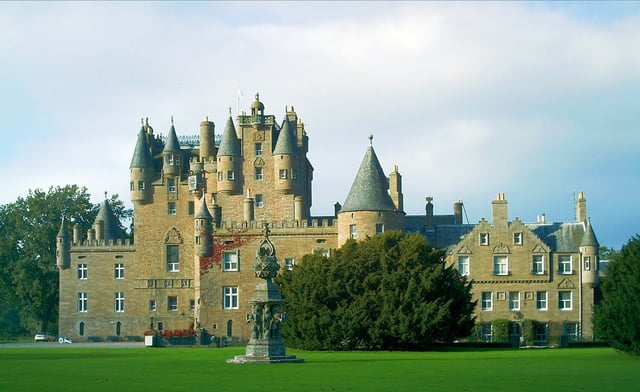
Glamis Castle, the Strathmores' Scottish home
Elizabeth Angela Marguerite Bowes-Lyon was the youngest daughter and the ninth of ten children of Claude Bowes-Lyon, Lord Glamis (later the 14th Earl of Strathmore and Kinghorne in the Peerage of Scotland), and his wife, Cecilia Cavendish-Bentinck. Her mother was descended from British Prime Minister William Cavendish-Bentinck, 3rd Duke of Portland, and Governor-General of India Richard Wellesley, 1st Marquess Wellesley, who was the elder brother of another Prime Minister, Arthur Wellesley, 1st Duke of Wellington.[2]
The location of her birth remains uncertain, but reputedly she was born either in her parents' Westminster home at Belgrave Mansions, Grosvenor Gardens, or in a horse-drawn ambulance on the way to a hospital.[10] Other possible locations include Forbes House in Ham, London, the home of her maternal grandmother, Louisa Scott.[11] Her birth was registered at Hitchin, Hertfordshire,[12] near the Strathmores' English country house, St Paul's Walden Bury, which was also given as her birthplace in the census the following year.[13] She was christened there on 23 September 1900, in the local parish church, All Saints, and her godparents included her paternal aunt Lady Maud Bowes-Lyon and cousin Venetia James.[14]
She spent much of her childhood at St Paul's Walden and at Glamis Castle, the Earl's ancestral home in Scotland. She was educated at home by a governess until the age of eight, and was fond of field sports, ponies and dogs.[15] When she started school in London, she astonished her teachers by precociously beginning an essay with two Greek words from Xenophon's Anabasis. Her best subjects were literature and scripture. After returning to private education under a German Jewish governess, Käthe Kübler, she passed the Oxford Local Examination with distinction at age thirteen.[16]
On her fourteenth birthday, Britain declared war on Germany. Four of her brothers served in the army. Her elder brother, Fergus, an officer in the Black Watch Regiment, was killed in action at the Battle of Loos in 1915. Another brother, Michael, was reported missing in action on 28 April 1917.[17] Three weeks later, the family discovered he had been captured after being wounded. He remained in a prisoner of war camp for the rest of the war. Glamis was turned into a convalescent home for wounded soldiers, which Elizabeth helped to run. She was particularly instrumental in organising the rescue of the castle's contents during a serious fire on 16 September 1916.[18] One of the soldiers she treated wrote in her autograph book that she was to be "Hung, drawn, & quartered ... Hung in diamonds, drawn in a coach and four, and quartered in the best house in the land."[19]
Marriage to Prince Albert
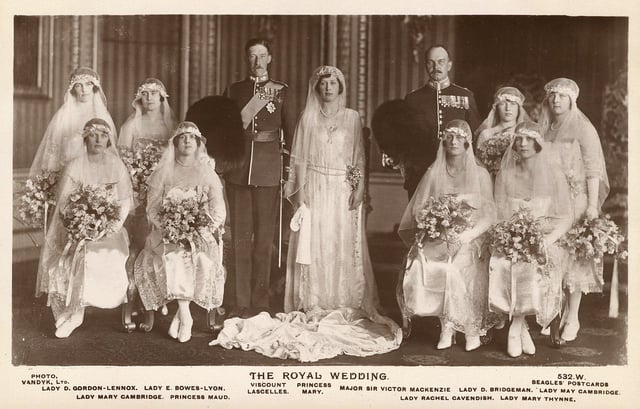
Elizabeth (back row second from left) as a bridesmaid at the wedding of Princess Mary and Viscount Lascelles, 1922
Prince Albert, Duke of York—"Bertie" to the family—was the second son of King George V. He initially proposed to Elizabeth in 1921, but she turned him down, being "afraid never, never again to be free to think, speak and act as I feel I really ought to".[20] When he declared he would marry no other, his mother, Queen Mary, visited Glamis to see for herself the girl who had stolen her son's heart. She became convinced that Elizabeth was "the one girl who could make Bertie happy", but nevertheless refused to interfere.[21] At the same time, Elizabeth was courted by James Stuart, Albert's equerry, until he left the Prince's service for a better-paid job in the American oil business.[22]
In February 1922, Elizabeth was a bridesmaid at the wedding of Albert's sister, Princess Mary, to Viscount Lascelles.[23] The following month, Albert proposed again, but she refused him once more.[24] Eventually, in January 1923, Elizabeth agreed to marry Albert, despite her misgivings about royal life.[25] Albert's freedom in choosing Elizabeth, not a member of a royal family, though the daughter of a peer, was considered a gesture in favour of political modernisation; previously, princes were expected to marry princesses from other royal families.[26] They selected a platinum engagement ring featuring a Kashmir sapphire with two diamonds adorning its sides.[27]
They married on 26 April 1923, at Westminster Abbey. Unexpectedly,[28] Elizabeth laid her bouquet at the Tomb of the Unknown Warrior on her way into the abbey,[29] in memory of her brother Fergus.[30] Elizabeth became styled Her Royal Highness The Duchess of York.[31] Following a wedding breakfast at Buckingham Palace prepared by chef Gabriel Tschumi, the new Duchess and her husband honeymooned at Polesden Lacey, a manor house in Surrey, and then went to Scotland, where she caught "unromantic" whooping cough.[32]
Duchess of York (1923–1936)
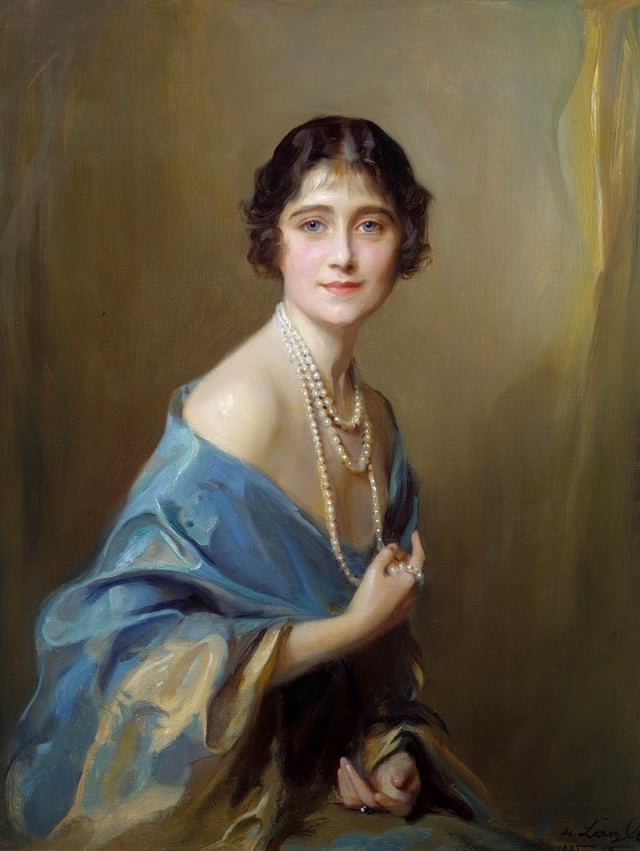
Portrait by Philip de László, 1925
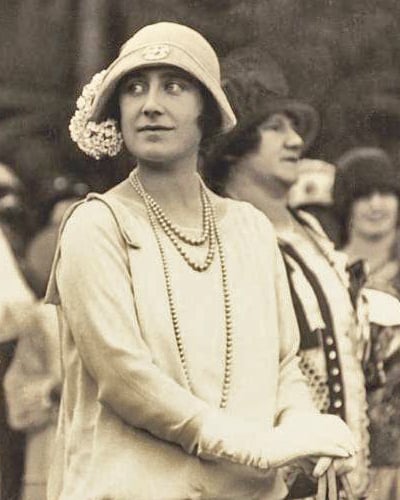
The Duchess of York in Queensland, 1927
After a successful visit to Northern Ireland in July 1924, the Labour government agreed that Albert and Elizabeth could tour East Africa from December 1924 to April 1925.[33] The Labour government was defeated by the Conservatives in a general election in November (which Elizabeth described as "marvellous" to her mother)[34] and the Governor-General of Anglo-Egyptian Sudan, Sir Lee Stack, was assassinated three weeks later. Despite this, the tour went ahead, and they visited Aden, Kenya, Uganda, and Sudan, but Egypt was avoided because of political tensions.[35]
Albert had a stammer, which affected his ability to deliver speeches, and after October 1925, Elizabeth assisted in helping him through the therapy devised by Lionel Logue, an episode portrayed in the 2010 film The King's Speech. In 1926, the couple had their first child, Princess Elizabeth—"Lilibet" to the family—who would later become Queen Elizabeth II. Another daughter, Princess Margaret Rose, was born four years later. Albert and Elizabeth, without their child, travelled to Australia to open Parliament House in Canberra in 1927.[36] She was, in her own words, "very miserable at leaving the baby".[37] Their journey by sea took them via Jamaica, the Panama Canal and the Pacific; Elizabeth fretted constantly over her baby back in Britain, but their journey was a public relations success.[38] She charmed the public in Fiji when, shaking hands with a long line of official guests, a stray dog walked in on the ceremony and she shook its paw as well.[39] In New Zealand she fell ill with a cold and missed some engagements, but enjoyed the local fishing[40] in the Bay of Islands accompanied by Australian sports fisherman Harry Andreas.[41] On the return journey, via Mauritius, the Suez Canal, Malta and Gibraltar, their transport, HMS Renown, caught fire and they prepared to abandon ship before the fire was brought under control.[42]
Accession and abdication of Edward VIII
On 20 January 1936, King George V died and Albert's brother, Edward, Prince of Wales, became King Edward VIII. George had expressed private reservations about his successor, saying, "I pray God that my eldest son will never marry and that nothing will come between Bertie and Lilibet and the throne."[43]
Just months into his reign, Edward forced a constitutional crisis by insisting on marrying the American divorcée Wallis Simpson. Although legally Edward could have married Simpson, as King he was also head of the Church of England, which at that time did not allow divorced people to remarry. Edward's ministers believed that the people would never accept Simpson as Queen and advised against the marriage. As a constitutional monarch, Edward was obliged to follow ministerial advice.[44]
Rather than abandon his plans to marry Simpson, he chose to abdicate in favour of Albert,[45] who reluctantly became King in his place on 11 December 1936 under the regnal name of George VI. George VI and Elizabeth were crowned King and Queen of Great Britain, Ireland and the British Dominions, and Emperor and Empress of India in Westminster Abbey on 12 May 1937, the date previously scheduled for Edward VIII. Elizabeth's crown was made of platinum and was set with the Koh-i-Noor diamond.[46]
Edward and Simpson married and became the Duke and Duchess of Windsor, but while Edward was a Royal Highness, George VI withheld the style from the Duchess, a decision that Elizabeth supported.[47] Elizabeth was later quoted as referring to the Duchess as "that woman",[48] and the Duchess referred to Elizabeth as "Cookie", because of her supposed resemblance to a fat Scots cook.[7] Claims that Elizabeth remained embittered towards the Duchess were denied by her close friends; the Duke of Grafton wrote that she "never said anything nasty about the Duchess of Windsor, except to say she really hadn't got a clue what she was dealing with."[49]
Queen consort (1936–1952)
State visits and royal tour

Portrait by Sir Gerald Kelly. Her crown is on the left.
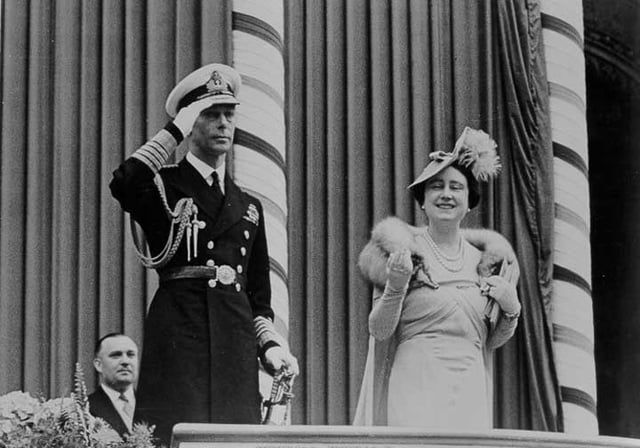
King George VI and Queen Elizabeth at Toronto City Hall, 1939
In summer 1938, a state visit to France by the King and Queen was postponed for three weeks because of the death of the Queen's mother, Lady Strathmore. In two weeks, Norman Hartnell created an all-white trousseau for the Queen, who could not wear colours as she was still in mourning.[50] The visit was designed to bolster Anglo-French solidarity in the face of aggression from Nazi Germany.[51] The French press praised the demeanour and charm of the royal couple during the delayed but successful visit, augmented by Hartnell's wardrobe.[52]
Nevertheless, Nazi aggression continued, and the government prepared for war. After the Munich Agreement of 1938 appeared to forestall the advent of armed conflict, the British Prime Minister Neville Chamberlain was invited onto the balcony of Buckingham Palace with the King and Queen to receive acclamation from a crowd of well-wishers.[53] While broadly popular among the general public, Chamberlain's policy towards Hitler was the subject of some opposition in the House of Commons, which led historian John Grigg to describe the King's behaviour in associating himself so prominently with a politician as "the most unconstitutional act by a British sovereign in the present century".[54] However, historians argue that the King only ever followed ministerial advice and acted as he was constitutionally bound to do.[55]
In May and June 1939, Elizabeth and her husband toured Canada from coast to coast and back, and visited the United States, spending time with President Roosevelt at the White House and his Hudson Valley estate.[56][57][58][59] U.S. First Lady Eleanor Roosevelt said that Elizabeth was "perfect as a Queen, gracious, informed, saying the right thing & kind but a little self-consciously regal".[60] The tour was designed to bolster trans-Atlantic support in the event of war, and to affirm Canada's status as an independent kingdom sharing with Britain the same person as monarch.[61][62][63][64]
According to an often-told story, during one of the earliest of the royal couple's repeated encounters with the crowds, a Boer War veteran asked Elizabeth, "Are you Scots or are you English?" She replied, "I am a Canadian!"[65] Their reception by the Canadian and U.S. public was extremely enthusiastic,[66] and largely dissipated any residual feeling that George and Elizabeth were a lesser substitute for Edward.[67] Elizabeth told Canadian Prime Minister William Lyon Mackenzie King, "that tour made us",[68] and she returned to Canada frequently both on official tours and privately.[69]
Second World War
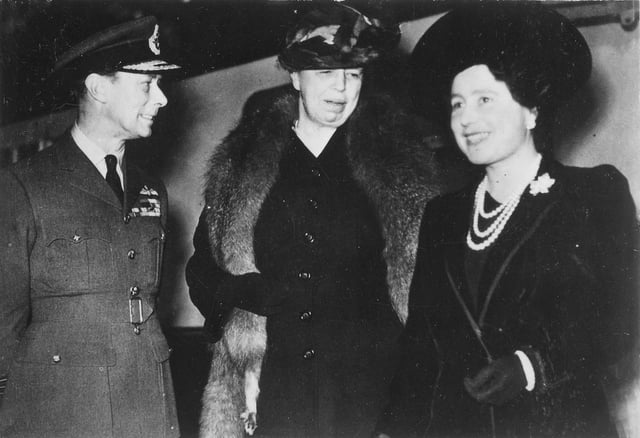
Eleanor Roosevelt (centre), King George VI and Queen Elizabeth in London, 23 October 1942

The Queen and Princess Elizabeth talk to paratroopers preparing for D-Day, 19 May 1944
During the Second World War, the King and Queen became symbols of the fight against fascism.[70] Shortly after the declaration of war, The Queen's Book of the Red Cross was conceived. Fifty authors and artists contributed to the book, which was fronted by Cecil Beaton's portrait of the Queen and was sold in aid of the Red Cross.[71] Elizabeth publicly refused to leave London or send the children to Canada, even during the Blitz, when she was advised by the Cabinet to do so. She declared, "The children won't go without me. I won't leave the King. And the King will never leave."[72]
Elizabeth visited troops, hospitals, factories, and parts of Britain that were targeted by the German Luftwaffe, in particular the East End, near London's docks. Her visits initially provoked hostility; rubbish was thrown at her and the crowds jeered,[7] in part because she wore expensive clothes that served to alienate her from people suffering the deprivations of war. She explained that if the public came to see her they would wear their best clothes, so she should reciprocate in kind; Norman Hartnell dressed her in gentle colours and avoided black to represent "the rainbow of hope".[73] When Buckingham Palace itself took several hits during the height of the bombing, Elizabeth was able to say, "I'm glad we've been bombed. It makes me feel I can look the East End in the face."[74]
Though the King and Queen spent the working day at Buckingham Palace, partly for security and family reasons they stayed at night at Windsor Castle about 20 miles (32 km) west of central London with the Princesses Elizabeth and Margaret. The Palace had lost much of its staff to the army, and most of the rooms were shut.[75] The windows were shattered by bomb blasts, and had to be boarded up.[76] During the "Phoney War" the Queen was given revolver training because of fears of imminent invasion.[77]
Adolf Hitler is said to have called her "the most dangerous woman in Europe" because he viewed her popularity as a threat to German interests.[78] However, before the war both she and her husband, like most of Parliament and the British public, had supported appeasement and Prime Minister Neville Chamberlain, believing after the experience of the First World War that war had to be avoided at all costs. After the resignation of Chamberlain, the King asked Winston Churchill to form a government. Although the King was initially suspicious of Churchill's character and motives, in due course both the King and Queen came to respect and admire him.[79][80]
Post-war years
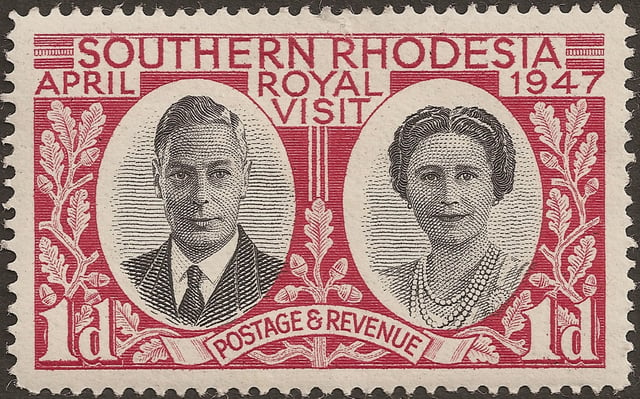
Southern Rhodesian stamp celebrating the 1947 royal tour of Southern Africa
In the 1945 British general election, Churchill's Conservative Party was soundly defeated by the Labour Party of Clement Attlee. Elizabeth's political views were rarely disclosed,[81] but a letter she wrote in 1947 described Attlee's "high hopes of a socialist heaven on earth" as fading and presumably describes those who voted for him as "poor people, so many half-educated and bemused. I do love them."[82] Woodrow Wyatt thought her "much more pro-Conservative" than other members of the royal family,[83] but she later told him, "I like the dear old Labour Party."[84] She also told the Duchess of Grafton, "I love communists."[85]
During the 1947 royal tour of South Africa, Elizabeth's serene public behaviour was broken, exceptionally, when she rose from the royal car to strike an admirer with her umbrella because she had mistaken his enthusiasm for hostility.[86] The 1948 royal tour of Australia and New Zealand was postponed because of the King's declining health. In March 1949, he had a successful operation to improve the circulation in his right leg.[87] In summer 1951, Elizabeth and her daughters fulfilled the King's public engagements in his place. In September, he was diagnosed with lung cancer.[88] After a lung resection, he appeared to recover, but the delayed trip to Australia and New Zealand was altered so that Princess Elizabeth and her husband, the Duke of Edinburgh, went in the King and Queen's place, in January 1952.[89] The King died in his sleep on 6 February 1952 while Princess Elizabeth and the Duke of Edinburgh were in Kenya en route to the southern hemisphere, and they returned immediately to London, as queen and prince consort.
Queen mother (1952–2002)
Widowhood
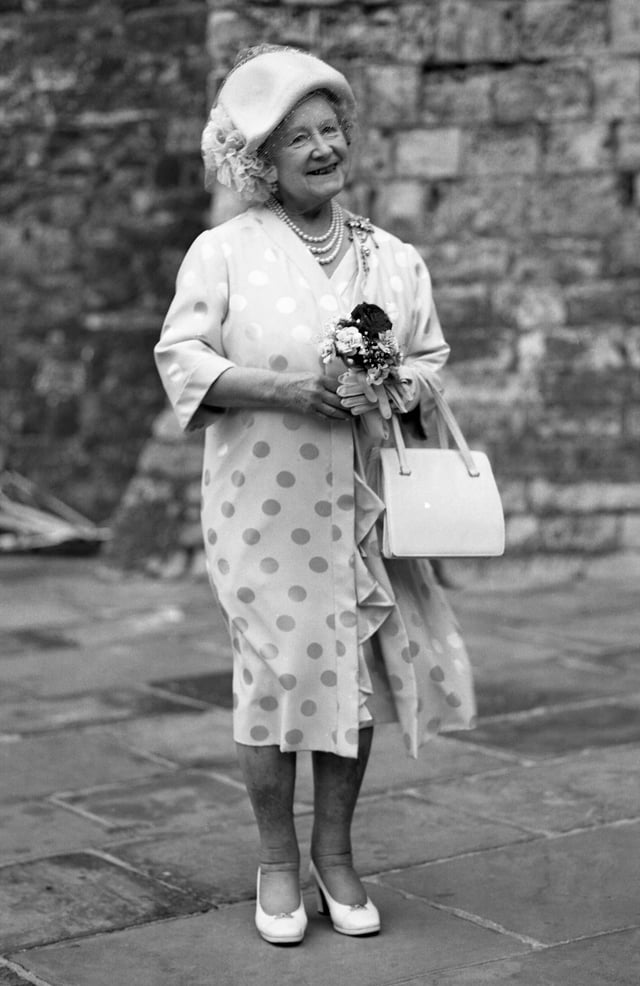
Elizabeth at Dover Castle, by Allan Warren
Shortly after George VI's death, Elizabeth began to be styled as Her Majesty Queen Elizabeth The Queen Mother because the normal style for the widow of a king, "Queen Elizabeth", would have been too similar to the style of her elder daughter, now Queen Elizabeth II.[90] Popularly, she became the "Queen Mother" or the "Queen Mum".[91] She was devastated by her husband's death and retired to Scotland. However, after a meeting with the Prime Minister, Winston Churchill, she broke her retirement and resumed her public duties.[92] Eventually she became just as busy as queen mother as she had been as queen consort. In July 1953, she undertook her first overseas visit since the funeral when she visited the Federation of Rhodesia and Nyasaland with Princess Margaret. She laid the foundation stone of the University College of Rhodesia and Nyasaland – the current University of Zimbabwe.[93] Upon her return to the region in 1957, Elizabeth was inaugurated as the College's President, and attended other events that were deliberately designed to be multi-racial.[94] During her daughter's extensive tour of the Commonwealth over 1953–54, Elizabeth acted as a Counsellor of State and looked after her grandchildren, Charles and Anne.[95] In February 1959, she visited Kenya and Uganda.[96][97]
Elizabeth oversaw the restoration of the remote Castle of Mey, on the north coast of Scotland, which she used to "get away from everything"[98] for three weeks in August and ten days in October each year.[99] She developed her interest in horse racing, particularly steeplechasing, which had been inspired by the amateur jockey Lord Mildmay in 1949.[100] She owned the winners of approximately 500 races. Her distinctive colours of blue with buff stripes were carried by horses such as Special Cargo, the winner of the 1984 Whitbread Gold Cup, and Devon Loch, which spectacularly halted just short of the winning post at the 1956 Grand National[101] and whose jockey Dick Francis later had a successful career as the writer of racing-themed detective stories. Peter Cazalet was her trainer for over 20 years. Although (contrary to rumour) she never placed bets, she did have the racing commentaries piped direct to her London residence, Clarence House, so she could follow the races.[102] As an art collector, she purchased works by Claude Monet, Augustus John and Peter Carl Fabergé, among others.[103]
In February 1964, Elizabeth had an emergency appendectomy, which led to the postponement of a planned tour of Australia, New Zealand and Fiji until 1966.[104] She recuperated during a Caribbean cruise aboard the royal yacht, Britannia.[105] In December 1966, she underwent an operation to remove a tumour after she was diagnosed with colon cancer. Contrary to rumours, she did not have a colostomy.[106][107] She was diagnosed with breast cancer in 1984 and a lump was removed from her breast. Her bouts with cancer were never made public during her lifetime.[108]
In 1982, Elizabeth was rushed to hospital when a fish bone became stuck in her throat, and had an operation to remove it. Being a keen angler, she calmly joked afterwards, "The salmon have got their own back."[109] Similar incidents occurred at Balmoral in August 1986, when she was hospitalised at Aberdeen Royal Infirmary overnight but no operation was needed,[110] and May 1993, when she was admitted to the Infirmary for surgery under general anaesthetic.[111]
In 1975, Elizabeth visited Iran at the invitation of Shah Mohammad Reza Pahlavi. The British ambassador and his wife, Anthony and Sheila Parsons, noted how the Iranians were bemused by her habit of speaking to everyone regardless of status or importance, and hoped the Shah's entourage would learn from the visit to pay more attention to ordinary people.[112] Between 1976 and 1984, she made annual summer visits to France,[113] which were among 22 private trips to continental Europe between 1963 and 1992.[114]
In 1987, Elizabeth was criticised when it emerged that two of her nieces, Katherine and Nerissa Bowes-Lyon, had both been committed to a psychiatric hospital because they were severely handicapped. However, Burke's Peerage had listed the sisters as dead, apparently because their mother, Fenella (Elizabeth's sister-in-law), "was 'extremely vague' when it came to filling in forms and might not have completed the paperwork for the family entry correctly".[115] When Nerissa died the year before, her grave was originally marked with a plastic tag and a serial number. Elizabeth said that the news of their institutionalisation came as a surprise to her.[116]
Centenarian

Elizabeth in 2000
In her later years, Elizabeth became known for her longevity. Her 90th birthday—4 August 1990—was celebrated by a parade on 27 June that involved many of the 300 organisations of which she was patron.[117] In 1995, she attended events commemorating the end of the war fifty years before, and had two operations: one to remove a cataract in her left eye, and one to replace her right hip.[118] In 1998, her left hip was replaced after it was broken when she slipped and fell during a visit to Sandringham stables.[119]
Elizabeth's 100th birthday was celebrated in a number of ways: a parade that celebrated the highlights of her life included contributions from Sir Norman Wisdom and Sir John Mills;[120] her image appeared on a special commemorative £20 note issued by the Royal Bank of Scotland;[121] and she attended a lunch at the Guildhall, London, at which George Carey, the Archbishop of Canterbury, accidentally attempted to drink her glass of wine. Her quick admonition of "That's mine!" caused widespread amusement.[122] In November 2000, she broke her collarbone in a fall that kept her recuperating at home over Christmas and the New Year.[123]
On 1 August 2001, Elizabeth had a blood transfusion for anaemia after suffering from mild heat exhaustion, though she was well enough to make her traditional appearance outside Clarence House three days later to celebrate her 101st birthday.[124][125] Her final public engagements included planting a cross at the Field of Remembrance on 8 November 2001;[126] a reception at the Guildhall, London, for the reformation of the 600 Squadron, Royal Auxiliary Air Force on 15 November;[127] and attending the re-commissioning of HMS Ark Royal on 22 November.[128][129]
In December 2001, aged 101, Elizabeth fractured her pelvis in a fall. Even so, she insisted on standing for the National Anthem during the memorial service for her husband on 6 February the following year.[130] Just three days later, her second daughter Princess Margaret died. On 13 February 2002, Elizabeth fell and cut her arm in her sitting room at Sandringham House; an ambulance and doctor were called, and the wound was dressed.[131] She was still determined to attend Margaret's funeral at St George's Chapel, Windsor Castle, two days later on the Friday of that week,[132] even though the Queen and the rest of the royal family were concerned about the journey the Queen Mother would face to get from Norfolk to Windsor;[133] she was also rumoured to be hardly eating. Nevertheless, she flew to Windsor by helicopter, and so that no photographs of her in a wheelchair could be taken—she insisted that she be shielded from the press[133]—she travelled to the service in a people carrier with blacked–out windows,[134][135] which had been previously used by Margaret.[133][136]
On 5 March 2002, Elizabeth was present at the luncheon of the annual lawn party of the Eton Beagles, and watched the Cheltenham Races on television; however, her health began to deteriorate precipitously during her last weeks after retreating to Royal Lodge for the final time.[137]
Death
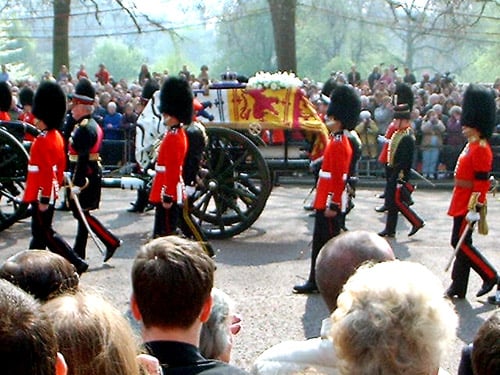
The Queen Mother's funeral carriage. The coffin is draped with her personal standard, shown below.
On 30 March 2002, at 15:15 (GMT), Elizabeth died in her sleep at the Royal Lodge, Windsor Great Park, with her surviving daughter, Queen Elizabeth II, at her bedside.[129] She had been suffering from a cold for the previous four months.[131] At 101 years and 238 days old she was the longest-lived member of the royal family in British history. Her last surviving sister-in-law, Princess Alice, Duchess of Gloucester,[138] exceeded that, dying aged 102 on 29 October 2004.[139]
Elizabeth grew camellias in every one of her gardens, and before her flag-draped coffin was taken from Windsor to lie in state at Westminster Hall, an arrangement of camellias from her own gardens was placed on top.[140] An estimated 200,000 people over three days filed past as she lay in state in Westminster Hall at the Palace of Westminster.[141] Members of the household cavalry and other branches of the armed forces stood guard at the four corners of the catafalque. At one point, her four grandsons Prince Charles, Prince Andrew, Prince Edward and Viscount Linley mounted the guard as a mark of respect—an honour similar to the Vigil of the Princes at the lying in state of King George V.[142][143]
On the day of her funeral, 9 April, the Governor General of Canada issued a proclamation asking Canadians to honour Elizabeth's memory that day.[144] In Australia, the Governor-General read the lesson at a memorial service held in St Andrew's Cathedral, Sydney.[145]
In London, more than a million people filled the area outside Westminster Abbey and along the 23-mile (37 km) route from central London to Elizabeth's final resting place beside her husband and younger daughter in St George's Chapel, Windsor Castle.[146] At her request, after her funeral the wreath that had lain atop her coffin was placed on the Tomb of the Unknown Warrior, in a gesture that echoed her wedding-day tribute 79 years before.[147]
Legacy
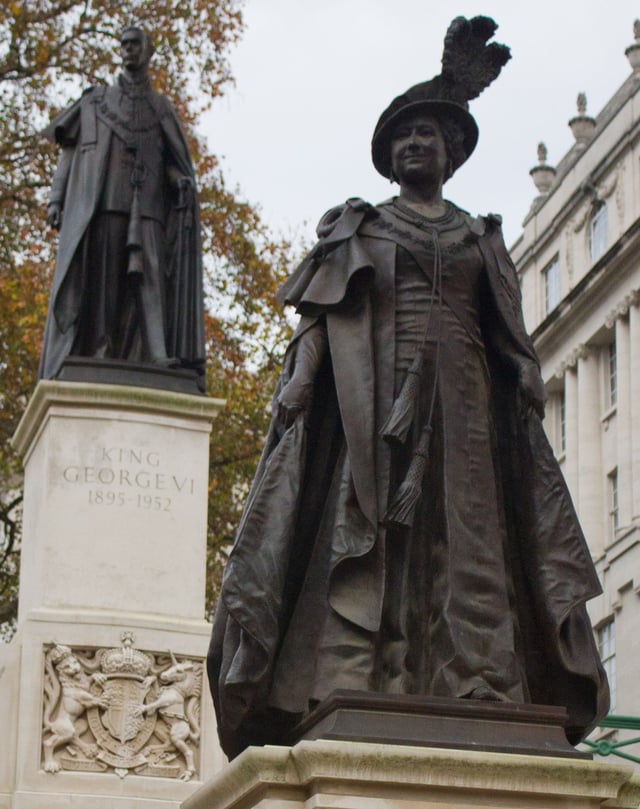
Bronze statue of Elizabeth on The Mall, London, overlooked by the statue of her husband King George VI
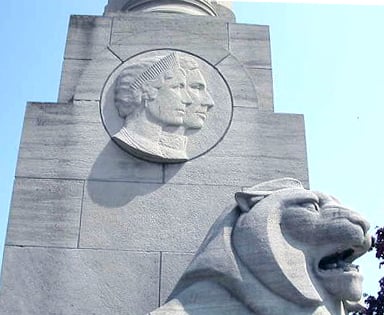
The Queen Elizabeth Way Monument, near Toronto, with a bas-relief of Queen Elizabeth and King George VI
Critics included Kitty Kelley, who falsely alleged that during the Second World War Elizabeth did not abide by the rationing regulations.[151][152] This, however, was contradicted by the official records,[153][154] and Eleanor Roosevelt during her wartime stay at Buckingham Palace reported expressly on the rationed food served in the Palace and the limited bathwater that was permitted.[155][156] Claims that Elizabeth used racist slurs to refer to black people[151] were strongly denied by Major Colin Burgess,[157] the husband of Elizabeth Burgess, a mixed-race secretary who accused members of Prince Charles's Household of racial abuse.[158] Elizabeth made no public comments on race, but according to Robert Rhodes James in private she "abhorred racial discrimination" and decried apartheid as "dreadful".[159] Woodrow Wyatt records in his diary that when he expressed the view that non-white countries have nothing in common with "us", she told him, "I am very keen on the Commonwealth. They're all like us."[160] However, she did distrust Germans; she told Woodrow Wyatt, "Never trust them, never trust them."[161] While she may have held such views, it has been argued that they were normal for British people of her generation and upbringing, who had experienced two vicious wars with Germany.[162]
In his official biography, William Shawcross portrays Elizabeth as a person whose indomitable optimism, zest for life, good manners, mischievous sense of humour, and interest in people and subjects of all kinds contributed to her exceptional popularity and to her longevity. Sir Hugh Casson said Elizabeth was like "a wave breaking on a rock, because although she is sweet and pretty and charming, she also has a basic streak of toughness and tenacity. ... when a wave breaks on a rock, it showers and sparkles with a brilliant play of foam and droplets in the sun, yet beneath is really hard, tough rock, fused, in her case, from strong principles, physical courage and a sense of duty."[163] Sir Peter Ustinov described her during a student demonstration at the University of Dundee in 1968:
As we arrived in a solemn procession the students pelted us with toilet rolls. They kept hold of one end, like streamers at a ball, and threw the other end. The Queen Mother stopped and picked these up as though somebody had misplaced them. [Returning them to the students she said,] 'Was this yours? Oh, could you take it?' And it was her sang-froid and her absolute refusal to be shocked by this, which immediately silenced all the students. She knows instinctively what to do on those occasions. She doesn't rise to being heckled at all; she just pretends it must be an oversight on the part of the people doing it. The way she reacted not only showed her presence of mind, but was so charming and so disarming, even to the most rabid element, that she brought peace to troubled waters.[164]
Elizabeth was well known for her dry witticisms. On hearing that Edwina Mountbatten was buried at sea, she said: "Dear Edwina, she always liked to make a splash."[109] Accompanied by the gay writer Sir Noël Coward at a gala, she mounted a staircase lined with Guards. Noticing Coward's eyes flicker momentarily across the soldiers, she murmured to him: "I wouldn't if I were you, Noël; they count them before they put them out."[165]
After being advised by a Conservative Minister in the 1970s not to employ homosexuals, Elizabeth observed that without them, "we'd have to go self-service".[165] On the fate of a gift of a nebuchadnezzar of champagne (20 bottles' worth) even if her family did not come for the holidays, she said, "I'll polish it off myself."[166] Emine Saner of The Guardian suggests that with a gin and Dubonnet at noon, red wine with lunch, a port and martini at 6 pm and two glasses of champagne at dinner, "a conservative estimate puts the number of alcohol units she drank at 70 a week".[167] Her lifestyle amused journalists, particularly when it was revealed she had a multi-million pound overdraft with Coutts Bank.[168]
Her habits were parodied by the satirical 1980s television programme Spitting Image.[169] This was the first satirical depiction on television; the makers initially demurred from featuring her, fearing that it would be considered off-limits by most of the viewing public.[170] In the end, she was portrayed as a perpetually tipsy Beryl Reid soundalike.[171] She was portrayed by Juliet Aubrey in Bertie and Elizabeth, Sylvia Syms in The Queen, Natalie Dormer in W.E., Olivia Colman in Hyde Park on Hudson, Victoria Hamilton in The Crown, and in The King's Speech by Helena Bonham Carter, who was nominated for an Academy Award for Best Supporting Actress and won a BAFTA Award for Best Actress in a Supporting Role for her portrayal.[172][173]
The Cunard White Star Line's RMS Queen Elizabeth was named after her. She launched the ship on 27 September 1938 in Clydebank, Scotland. Supposedly, the liner started to slide into the water before Elizabeth could officially launch her, and acting sharply, she managed to smash a bottle of Australian red over the liner's bow just before it slid out of reach.[174] In 1954, Elizabeth sailed to New York on her namesake.[175]
A statue of Elizabeth by sculptor Philip Jackson was unveiled in front of the George VI Memorial, off The Mall, London, on 24 February 2009, creating the King George VI and Queen Elizabeth Memorial.[176]
In March 2011, her eclectic musical taste was revealed when details of her small record collection kept at the Castle of Mey were made public. Her records included ska, local folk, Scottish reels and the musicals Oklahoma! and The King and I, and artists such as yodeller Montana Slim, Tony Hancock, The Goons and Noël Coward.[177]
Eight years before her death, she had reportedly placed two-thirds of her money (an estimated £19 million)[178] into trusts, for the benefit of her great-grandchildren.[179] In her lifetime, she received £643,000 a year from the Civil List, and spent an estimated £1–2 million annually to run her household.[180] By the end of the 1990s, her overdraft was said to be around £4 million.[178][180] She left the bulk of her estate, estimated to be worth between £50 and £70 million, including paintings, Fabergé eggs, jewellery, and horses, to her surviving daughter, Queen Elizabeth II.[179][181] Under an agreement reached in 1993,[182] property passing from monarch to monarch is exempt from inheritance tax, as is property passing from the consort of a former monarch to the current monarch, so a tax liability estimated at £28 million (40 percent of the value of the estate) was not incurred.[183] The most important pieces of art were transferred to the Royal Collection by Elizabeth II.[179] Following her death, the Queen successfully applied to the High Court so that details of her mother's will would be kept secret.[184] This brought criticism from the Labour Party politicians and segments of the public, and the Queen eventually released the outlines of her mother's will.[181]
Titles, styles, honours and arms
Titles and styles
1900–1904: The Honourable Elizabeth Bowes-Lyon
1904–1923: Lady Elizabeth Bowes-Lyon
1923–1936: Her Royal Highness The Duchess of York
1936–1952: Her Majesty The Queen
1952–2002: Her Majesty Queen Elizabeth The Queen Mother
Arms
Elizabeth's coat of arms was the royal coat of arms of the United Kingdom (in either the English or the Scottish version) impaled with the arms of her father, the Earl of Strathmore; the latter being: 1st and 4th quarters, Argent, a lion rampant Azure, armed and langued Gules, within a double tressure flory-counter-flory of the second (Lyon); 2nd and 3rd quarters, Ermine, three bows stringed paleways proper (Bowes).[185] The shield is surmounted by the imperial crown, and supported by the crowned lion of England and a lion rampant per fess Or and Gules.[186]
Issue
| Name | Birth | Death | Marriage | Their children | Their grandchildren | |
|---|---|---|---|---|---|---|
| Date | Spouse | |||||
| Queen Elizabeth II | 21 April 1926 | 20 November 1947 | Prince Philip, Duke of Edinburgh | Charles, Prince of Wales | Prince William, Duke of Cambridge Prince Harry, Duke of Sussex | |
| Anne, Princess Royal | Peter Phillips Zara Tindall | |||||
| Prince Andrew, Duke of York | Princess Beatrice of York Princess Eugenie | |||||
| Prince Edward, Earl of Wessex | Lady Louise Windsor James, Viscount Severn | |||||
| Princess Margaret | 21 August 1930 | 9 February 2002 | 6 May 1960 Divorced 11 July 1978 | Antony Armstrong-Jones, 1st Earl of Snowdon | David Armstrong-Jones, 2nd Earl of Snowdon | Charles Armstrong-Jones, Viscount Linley Lady Margarita Armstrong-Jones |
| Lady Sarah Chatto | Samuel Chatto Arthur Chatto | |||||

